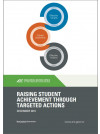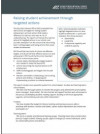In 2015,ERO investigated target setting in both primary and secondary schools. We focused on the extent to which targeted actions of schools supported accelerated progress for students at risk of not achieving.
Purpose
In this evaluation the Education Review Office (ERO) investigated the extent that targeted actions of schools supported the rate of progress of students who were at risk of not achieving. ERO did this to understand:
- how setting and responding to annual targets helped schools make a difference for selected students and reduced the gap in student achievement
- how actions in setting targets for selected students improved teaching practice
- how strategic and evaluative capability [1] of leaders in participating schools was applied in the school improvement process. [2]
Methodology
ERO focused on two key areas in the evaluation:
Effective target setting. This was defined by three criteria:
- scanning achievement data
- targets building on previous year’s outcomes
- targets having ‘buy in’ from teachers and students.
Effective actions. This was defined as:
- a plan focused on underachievement
- the school having more than 40 percent of targeted students making accelerated progress.
Evaluation questions
ERO investigated how well schools were setting targets for achievement and implementing actions that make the expected difference for learners, particularly for those learners at risk of underachieving. The study focused on how well school plans for improvement in achievement linked to actions that made a difference for targeted learners. The three evaluation questions were:
To what extent did the school meet the selected 2014 achievement target?
How well were the planned 2014 actions implemented and monitored?
How well was the 2015 target set?
Participants
All schools [37] reviewed in Terms 1 and 2, 2015 were involved in the national evaluation. The evaluation included 41 secondary schools and 296 primary schools.
In each school ERO investigated the impact of one 2014 board achievement target that focused on those students at risk of poor educational outcomes. ERO also investigated the quality of the 2015 achievement target.
Investigative themes
ERO evaluated the resulting shifts in achievement for students in the target group and the factors involved. ERO reviewers explored whether:
- schools knew why targeting particular students was important
- schools were targeting students most at risk of poor educational outcomes
- teachers and leaders knew the needs, strengths and interests of the students who most needed help to make the biggest shifts
- schools had planned actions for accelerating progress for targeted students that made a significant difference
- teachers, the target students and their parents were all committed to the selected achievement focus
- teachers, the target students and their parents knew what they needed to do to make the agreed improvement
- planned actions from targets led to more effective teaching
- the actions schools implemented led to more students experiencing success.
Synthesis
Key domains from ERO’s 2015 School Evaluation Indicators [38] were used as follows in the final stage of the synthesis to:
- identify overall patterns in key findings
- frame conclusions in this report.
The key domains from ERO’s 2015 School Evaluation Indicators referred to in figures in this report are:
- Stewardship
- Leadership
- Responsive curriculum,
- Effective teaching and opportunity to learn
- Professional capability and capacity building
Key Results
ERO found that almost two thirds of the schools in the sample set targets that focused on underachievement. However, only about a half of the schools took actions that accelerated progress for more than 40 percent of their targeted students. [16]
Some of the schools successfully accelerated the achievement of more than 70 percent of their target group. In these schools, targets made a real difference by focusing on both ‘raising the bar’ in overall achievement (excellence) and ‘lifting the level’ of underachievement to close the gap (equity). The target students were clearly identified, and board members, leaders, teachers, parents and whānau and students all knew what they had to do to make the desired improvement. In the best instances, schools provided targeted support for the students not achieving well and, at the same time, built teacher capability to avoid such underachievement in the future. Both students and teachers in these schools were energised by their visible success.
In schools that were not successful, a variety of issues hindered progress. In some cases targets were too general, outlining the percentage of students to reach the target without identifying individual students, their specific needs, or actions needed to accelerate their progress. In other schools, targets clearly identified the groups of students and outlined actions, but the actions were not clear or followed through. As a result few students in the target group in these schools accelerated their progress.
Overall secondary schools in the sample were less effective than primary schools in most areas of setting targets and responsive actions (Table 1).
Table 1: Number of primary and secondary schools effective in setting and responding to targets
| 2014 actions too general and not focused on acceleration | In 2014 up to 40% of targeted learners accelerated their progress | In 2014, 40-69% of targeted learners accelerated their progress | In 2014 over 70% of targeted learners accelerated their progress |
| Primary: 57 | Primary: 110 | Primary: 79 | Primary: 64 |
| Secondary: 21 | Secondary: 4 | Secondary: 9 | Secondary: 7 |
Only half the secondary schools set targets that focused on improving outcomes for students at risk of not achieving. Even where the focus was on acceleration, secondary schools were often less effective in accelerating learning for the students in the target group than primary schools. They took fewer key actions for success, or did these less effectively, than the successful primary schools. Primary schools have more specific requirements to report each year on the numbers and proportions of students not achieving. As a result boards and leaders of primary schools were generally clearer about the groups of students that needed to accelerate than secondary schools were.


